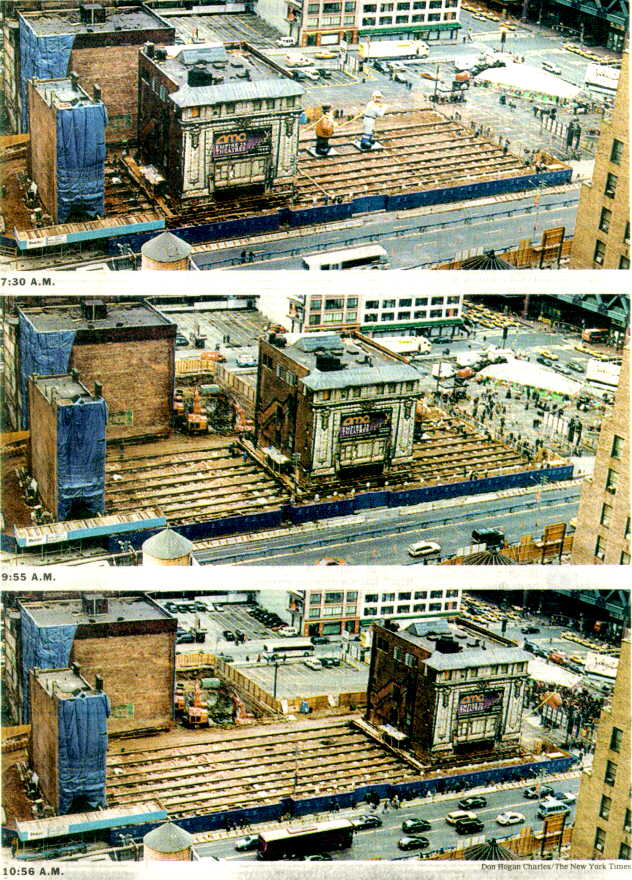
13 March 1998: Eliot Locitzer has renewed permission to include his drawings here.
4 March 1998: Extraordinary drawings of the moving system by Eliot Locitzer have been withdrawn at his request. They are worth seeing; request to Mr. Locitzer <eliotl@fcrc.com>, Forest City Ratner Companies, 1 MetroTech Center North, Brooklyn, NY 11021. 1-718-722-3500.
2 March 1998: Add NYT photos of move
1 March 1998

Photos: Hardcopy, Dan Hogan Charles / The New York Times, March
2, 1998, p.1
3,700-TON EMPIRE THEATER PICKED UP
AND MOVED ALONG 42ND STREET
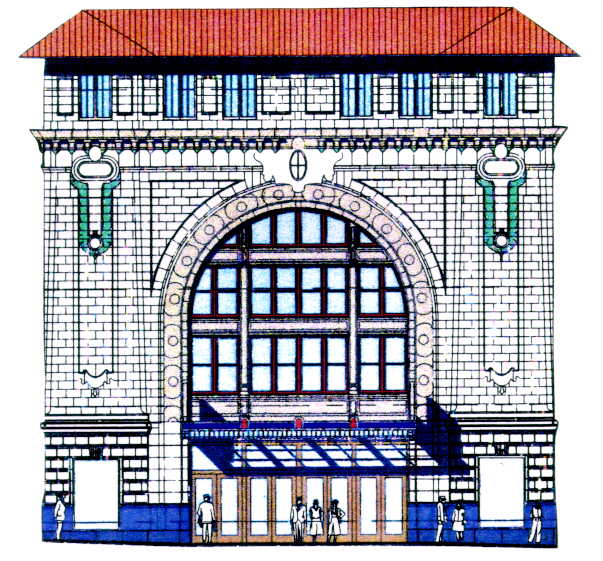
The Empire Theatre, built in 1912, has been moved to a new home,
some 168 feet west along 42nd Street. There, reclaimed and restored,
it will have a new role to play at the turn of a new century --
as the interior lobby of AMC's state-of-the-art,
25-screen multiplex cinema.
| Forest City Ratner Companies 1 MetroTech Center North Brooklyn, NY 11201 718 722 3500 718 722 3533 (Fax) |
Beyer Blinder Belle Architects & Planners LLP 41 East 11 Street New York, New York 10003 212 777 7800 212 475 7424 (Fax) |
NEW YORK, NY, March 1, 1998 - Forest City Ratner Companies, developer of
an entertainment-retail-restaurant complex on West 42nd Street, took a
significant first step toward its new project on Sunday, March 1, by physically
moving the historic Empire Theater from its original site. Following a plan
devised by Beyer Blinder Belle, an architectural firm that is noted for its
work in architectural preservation and adaptive re-use, Forest City Ratner
moved the 3,700-ton theater approximately 168 feet west along the south side
of 42nd Street. between Seventh and Eighth Avenues.

Drawings of the moving system by Eliot Locitzer, Project Manager,
Forest City Ratner Companies
Built in 1912 and originally called the Eltinge Theater, the Empire seats only 300 people, making it far too small to be economically viable today. Nevertheless, the guidelines for the 42nd Street Development Project require the preservation of the elegantly proportioned Beaux-Arts facade with its polychromed terra cotta and large arched window. Inside, the theater's tiny but beautiful auditorium has lost its eight boxes, but retains its elegant proportions and some original detail.
According to Bruce Ratner, President of Forest City Ratner Companies, "We saw early on that the Empire Theater would make a perfect entrance and grand lobby for one of the major pieces of our new complex, a 25-screen AMC movie house. But it was also obvious that the AMC megaplex should anchor our development at its west end -- and the Empire sits in the middle of the site."
"The first discussions had focused on dismantling the facade of the Empire
Theater and then re-erecting it on the new site," says Frederick Bland, Partner
in Charge of the project for Beyer Blinder Belle. "But when the beautiful
Thomas Lamb interior was discovered. it was decided to move the entire building
-- a much more interesting and historically legitimate approach to preserving
the structure. Under this plan the Empire will lose nothing but its old stage
and the fly loft, which no longer serve any purpose and have no historic
value, and Forest City Ratner will get a one-of-a-kind gateway for the
megaplex."
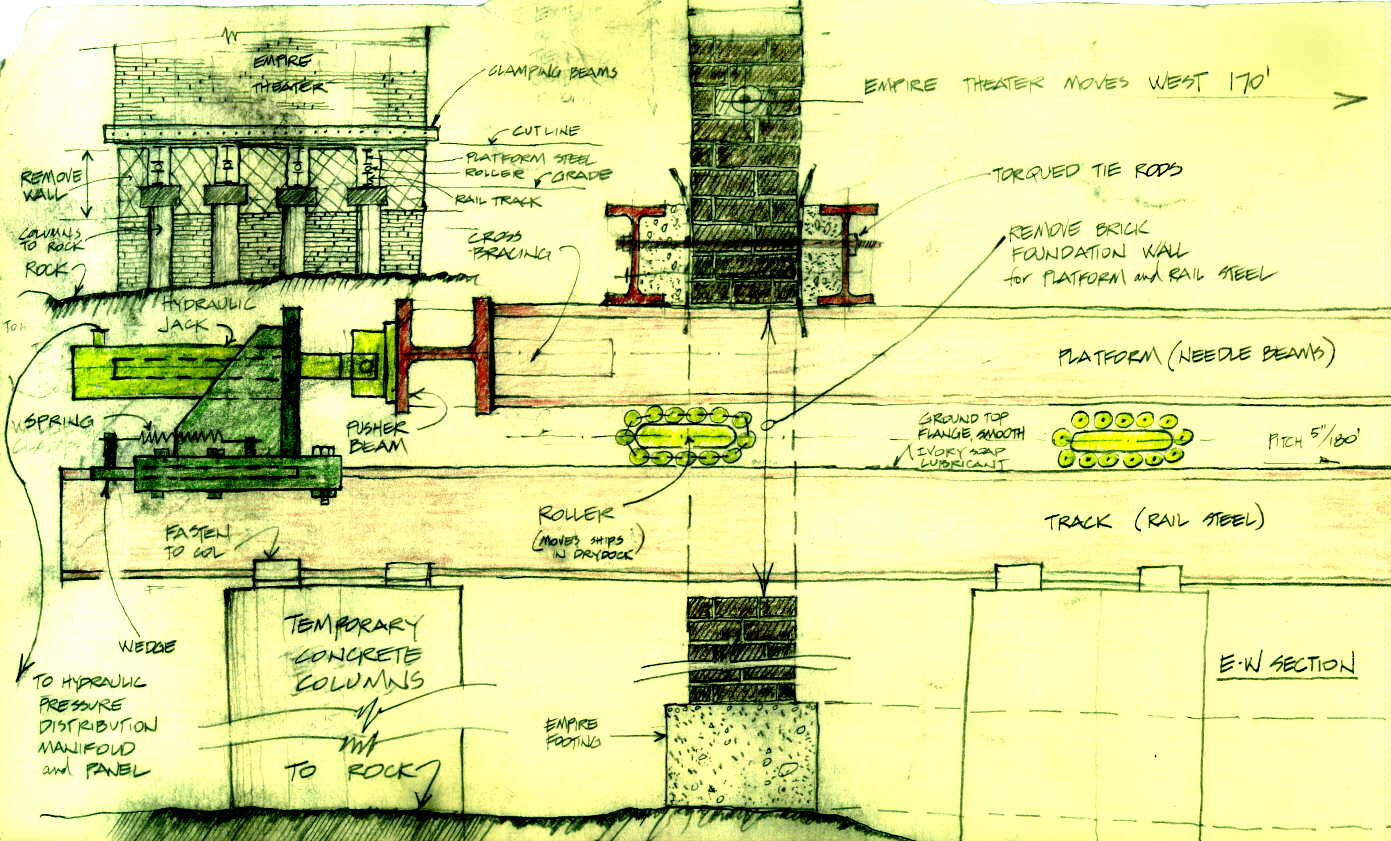
Preparations for the move began in early November 1997. Led by Lehrer McGovern Bovis, the Urban Foundation Company built a track system of eight rails parallel to 42nd Street. running from inside the building to the new location. Each of the rails is a wide flange steel beam, about 250 feet long. Inside the theater, the team also built a steel platform on top of the rails, bolting it to the building's walls with steel beams to hold it in place.
The next step was to cut the walls, so the building was separated from its original foundation and rested only on the steel platform. The team was then able to lift the whole structure l/8 of an inch, using hydraulic jacks. Steel rollers were inserted between the platform and the rails, after which the platform was lowered onto the rollers and the jacks removed.
On Sunday, March 1, a set of eight horizontally-oriented hydraulic jacks attached to the rails pushed the platform to the new site. The theater traveled at a rate of about one foot per minute, traveling the entire 168 feet over the course of six to eight hours. Once the theater reached its new site, the team lowered the building over a new foundation. New walls above the foundation will fill in the portions that were removed for the relocation.
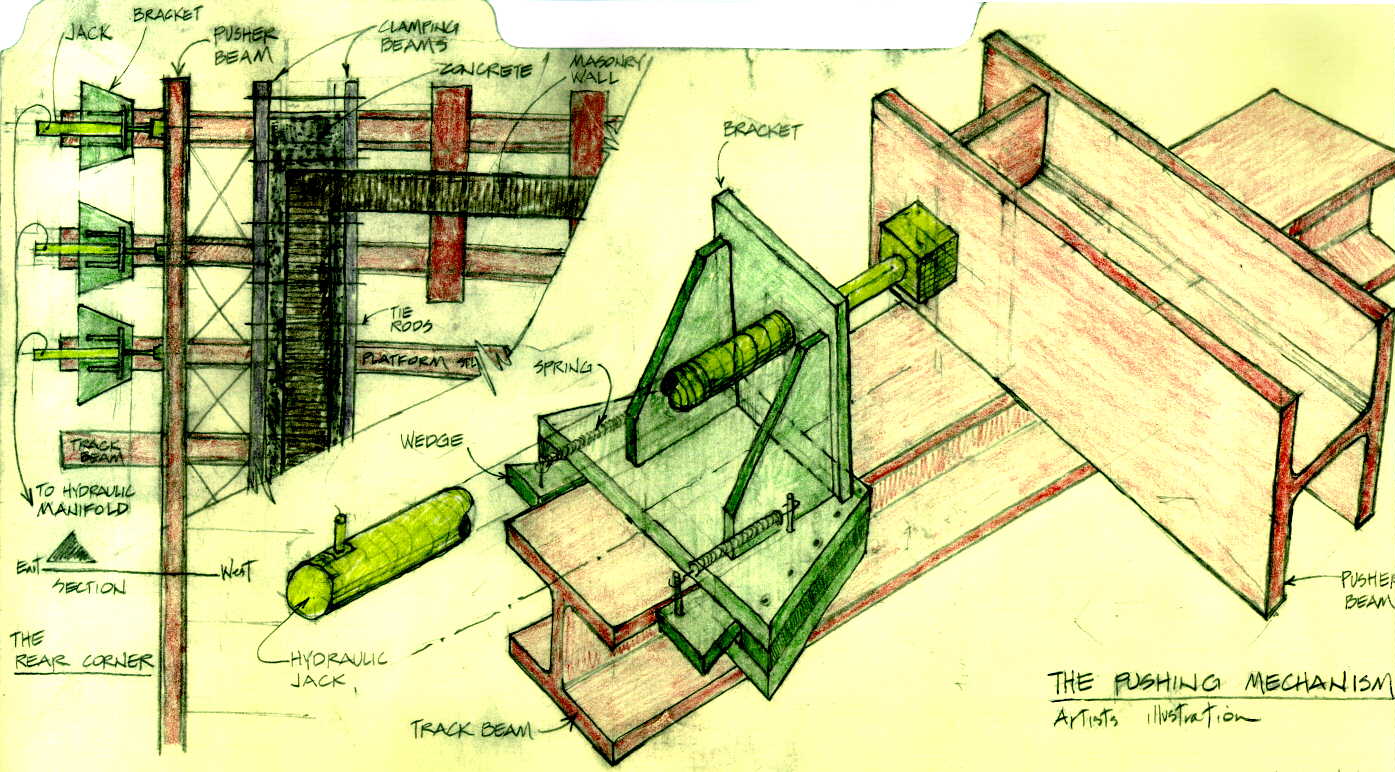
Working on the project with Beyer Blinder Belle are: Ysrael A. Seinuk, P.C., as structural engineer; Lehrer McGovern Bovis, Inc., as construction manager; Edwards & Zuck, P.C.. as mechanical, electrical, and plumbing engineers; and Urban Foundation Company, Inc., as building mover.
In its new location, the Empire Theater will be part of a 335,000 square foot entertainment, retail, and restaurant complex being developed by Forest City Ratner.
The west anchor of the complex is a 25-screen, 5,000-seat, 140,000-square-foot
movie theater operated by AMC. Also in the complex, incorporating the historic
facade of the Harris and Liberty theaters, is America's first Madame Tussaud's
Wax Museum (70,000 square feet); Just For Feet, one of the country's most
popular stores for athletic footwear (20,000 square feet); HMV Records (20,000
square feet); and a variety of entertainment-retail stores and theme restaurants!
including Crazy Shirts (a California-based retailer with stores on the West
Coast and Hawaii). The architect for the entire complex is Beyer Blinder
Belle.
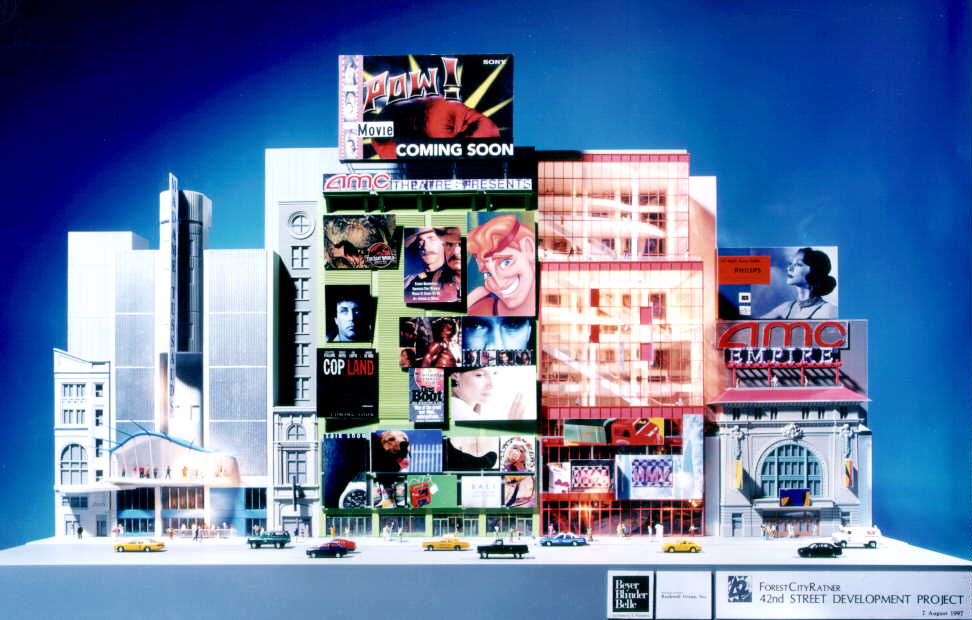
Photo: Copyright Peter Brandt Photography
The Empire opened in 1912 as the Eltinge Theater, built by manager and producer Al Woods for his star performer, female impersonator Julian Eltinge. The architect was Thomas Lamb, one of the era's most celebrated designers of theaters, who also was responsible for the Strand Theater (Broadway's first theater built exclusively for motion pictures), the Regency, and more than 300 other movie houses in New York City and around the world.
Notable legitimate productions at the Eltinge included Murder on the Second Floor (1929) starring Laurence Olivier and Love, Honor and Betray (1930) starring Clark Gable and Alice Brady. In 1931, the Eltinge became a burlesque house. As such, it made history in 1936, when a comedian from one of the regular acts decided to join forces with a straight man from another, forming the team of Abbott and Costello.
In 1942, Mayor Fiorello La Guardia issued an order closing the striptease houses in Midtown, and the Eltinge was shuttered. It then re-opened as a first-run movie house. In 1954. it was renamed the Empire Theater and became a second-run grind house. The theater closed in the mid-1980s.
Both the building of the Forest City Ratner complex and the preservation of the Empire Theater are taking place under the auspices of two agencies charged with the re-development of 42nd Street: the 42nd Street Development Project, a joint undertaking of the State of New York (through its Empire State Development Corporation) and City of New York (through its Economic Development Corporation); and The New 42nd Street, Inc., an independent, not-for profit organization.
Using a mixture of public and private initiatives, on both a for-profit and not-for-profit basis, the 42nd Street Development Project and The New 42nd Street, Inc. are bringing life back to the once-blighted Midtown block between Seventh and Eighth Avenues. A major undertaking of the 42nd Street Development Project was the leasing agreement with the Walt Disney Company for the restoration of the New Amsterdam Theatre, currently home to The I ion King.
The New 42nd Street, Inc. is charged with the preservation and adaptive re-use of seven historic mid-block theaters (Victory, Lyric, Apollo, Times Square and Selwyn on the north side of 42nd Street; Liberty and Empire on the south side). The Victory was restored by The New 42nd Street which operates it as The New Victory -- New York City's first theater for young people and their families. The Lyric and Apollo theaters have been merged into the Ford Center for the Performing Arts, designed by Beyer Blinder Belle. The Selwyn is to become the new main stage of the distinguished, not-for-profit Roundabout Theatre Company.
For further information:
| Beyer Blinder Belle: Claire Whittaker The Kreisberg Group, Ltd. (212) 799-5515 (telephone) (212) 799-5535 (telefax) |
Maxinne Leighton Beyer Blinder Belle (212) 777-7800 (telephone) (212) 475-7424 (telefax) |
Forest City Ratner: Joyce Baumgarten or Michele de Milly Geto & de Milly (212) 686-4551 |

WEST 42ND STREET PERSPECTIVE
Beyer Blinder Belle + The Rockwell Group + Lawrence Rosenbloom
Special appreciation to all those unnamed here on the
many teams who carried out the project
Relocation of the Empire Theater, situated on the south side of 42nd Street between Seventh and Eighth Avenues. To make way for a new entertainment-retail-restaurant complex into which the historic structure will be incorporated, the 3,700-ton theater is being moved 168 feet west.
Sunday, March 1,1998
Charles A. Gargano, Chairman
Li - Salzman Architects, Consulting Architect
Forest City Ratner Companies
Bruce Ratner, President
Eliot Locitzer, Project Manager
Beyer Blinder Belle Architects & Planners
Frederick Bland, FAIA, AICP, Partner in Charge
John Beyer, FAIA, Supporting Partner
Kip Wicke, AIA, Project Manager
Robert McMillian, Senior Products Architect
Charles Kramer, AIA, Historic Preservation Architect
Mei Chu, Project Architect
Stanley Wong, Architect
David Virgil, Architect
Franklin Lee, Superlative
Marcolm Young, Phenomenal
Ysrael A. Seinuk. P.C.
Jeff Smilow, Project Director
Lehrer McGovern Bovis. Inc.
Harold Lyons, Project Manager
Edwards & Zuck, P.C.
Peter Sposato, Partner in Charge
Chris Jones, Project Manager
Urban Foundation / Engineering, LLC.
Mel Febesh, Chairman
Leon Levy, Principal
Tony Mazzo, Project Manager
Rudi Van Leeuwen, PE, Consulting Engineer
The 3,700-ton Empire Theater, built in 1912, was moved at a rate of about one foot per minute, traveling 168 feet over the course of six to eight hours. Preparations for the move began in early November 1997 with construction of a track system of eight rails running parallel to 42nd Street, from inside the building to the new location. Each of the rails is a steel beam, 250 feet long. Inside the theater, a steel platform was built on top of the rails and fastened to the building's walls by steel beams. The walls were then cut, separating the structure from its original foundation, and the building lifted 1/8 of an inch by hydraulic jacks. Steel rollers were inserted between the platform and the rails, the platform was then lowered onto the rollers and the jacks removed. On March 1 eight horizontally-oriented hydraulic jacks attached to the rails pushed the platform to the new site, where it will be settled over a new foundation.
In its new location, the Empire Theater will become part of a 335,000 square foot entertainment, retail, and restaurant complex being developed by Forest City Ratner. The Empire Theater will be the west anchor of the complex, housing the entrance and lobby of a 25-screen, 5,000-seat, 140,000-sf AMC megaplex. Also in the complex, incorporating historic elements of the Harris and Liberty theaters, will be America's first Madame Tussaud's Wax Museum (70,000 sf); Just For Feet, one of the country's most popular stores for athletic footwear (20,000 sf); HMV Records (20,000 sf); and a variety of entertainment-retail stores and theme restaurants, including Crazy Shirts (a California-based retailer with stores on the West Coast and Hawaii). Architect: Beyer Blinder Belle
The preservation and re-use of the historic theaters on West 42nd Street is a primary goal of the 42nd Street Development Project -- a joint undertaking of the State of New York (through its Empire State Development Corporation) and the City of New York (through its Economic Development Corporation) -- and The New 42nd Street, Inc., a not-for-profit organization. Using a mixture of public and private initiatives, these organizations to date have been successful in encouraging the preservation and re-use of not only the Empire and Liberty theaters but also the Victory (now New Victory), New Amsterdam, Selwyn, Lyric and Apollo theaters.
For further information:
| Beyer Blinder Belle: Claire Whittaker The Kreisberg Group, Ltd. (212) 799-5515 (telephone) (212) 799-5535 (telefax) |
Maxinne Leighton Beyer Blinder Belle (212) 777-7800 (telephone) (212) 475-7424 (telefax) |
Forest City Ratner: Joyce Baumgarten or Michele de Milly Geto & de Milly (212) 686-4551 |